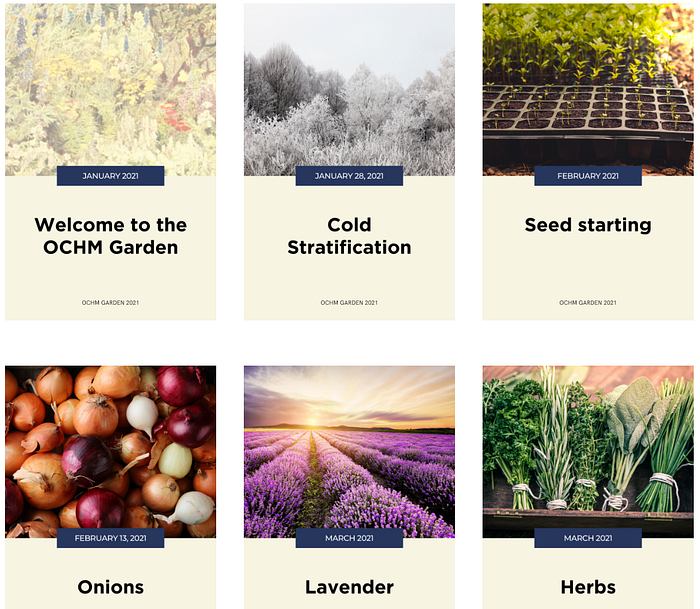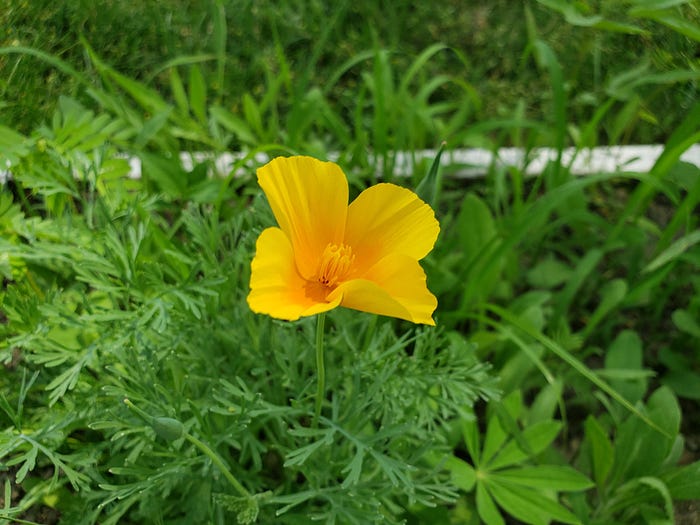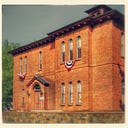Growing Local History: The OCHM Garden
by Katie MacDonald
A common first question in Introduction To Museum Studies in graduate school is “What is a museum?”. It’s a classic opening question asked to encourage conversation among a group of people about to study together and develop their professional approaches to museum work. Of course, there is no right answer and the ensuing discussion ranges from the emotional (“a place of reflection and discovery”) to the practical (“a place where important things are stored and preserved”) to the aspirational (“not a place but a community that comes together around a central theme or mission”).
The variety of the answers reveals the complexity of the question, and, in fact, the complexity of museums. They come in a variety of sizes, on a multitude of topics, all around the world, with budgets ranging from nothing to millions of dollars. As you might have noticed by now, this month we’re detouring the blog away from business as usual to talk about some of the most unusual business any of us have ever seen. July 7 marks one year since the OCHM re-opened after COVID; the first day we welcomed guests back to the museum following four months of being closed to the public. We re-opened safely, and socially-distanced thanks to the size of our historic building. Thankfully, we had experience with outdoor programs (walking tours and cemetery tours) and we had recently bought a tent so that indoor programs could become outdoor programs while the weather was kind to us.
Goodwill and people willing to adhere to safety guidelines got us back in action the first months of re-opening. We didn’t see our summer tourist bump, and we were doing more online than in person, of course. We kept thinking about big museum questions. How does a museum measure value if it isn’t in attendance dollars and donations? What is effective engagement if a program is done remotely? How do we teach history without being able to share objects and documents? What can we offer a community that needs connection but also needs to stay apart?
One answer to these questions came in the form of 3 yards of soil, a variety of seed packets, and our old miniature golf course. In our 168-year institutional history we had never seen anything like this, and so we started with the basics. What is a museum? What is an exhibit? What are we trying to say with this exhibit? We had four specific goals, and just now, one year after re-opening to a world of uncertainty, it is all starting to bloom.
Why did we plant a garden on the front lawn?
- It teaches local history.
Yes, they are plants, but the flora of the Old Colony is a vital part of our past, present, and future. We have traditional labels out in the garden with big topics such as: native wildflowers as fundamental to our ecosystem; herbs used in cooking and medicine; and vegetables that have both been grown locally for thousands of years as well as introduced by the people who have settled here in more recent centuries. We had so much to say that we started a garden blog to go along with the exhibit. We share articles that range from seed starting to heat-loving veggies, which shares not only our process, but also some historic resources in our collection and context to what we are growing. You can even find resources for becoming an advocate in your own yard and community, which we hope will be valuable long after the exhibit ends.

2. It is safe, free, and open to all.
When planning for our spring exhibit we were especially mindful of offering an experience for everyone in our local community. The entirety of the garden is outside and can be viewed in fresh air by anyone who may just be passing by. There is no admission to the garden. There is a bench to sit and stay to enjoy. We are offering garden tours every afternoon at 3 p.m. We are even giving away wildflower seed paper so that anyone who visits can start their own garden and continue the experience themselves. There should be no barrier to enjoying the beauty of a native wildflower with us or in nature.

3. It connects us to the larger world.
The COVID-19 pandemic was a stark reminder of how connected we all are on this planet. The garden exhibit is an opportunity to care for our local plot of earth and also discuss important climate issues that affect us all. Pollinators are in trouble. Since 1947 there has been a 60% drop in bee populations in Eastern North America due to climate change, pesticide use, and environmental loss. Bees and other animal pollinators (birds, bats, butterflies, moths, and insects) are crucial to our survival as more than 75% the world’s food depends on pollinators. Society has moved away from locally-produced foods and market gardens — not that long ago Taunton had more than a dozen grocery stores in business at the same time — but perhaps a more local approach to food could benefit our local pollinators, and ultimately, all of us.

4. It offers levels and variety of engagement — something for everyone.
Thanks to a digital capacity grant from Mass Humanities, we have been able to greatly expand the ways in which we are presenting this exhibit. There is an in-person experience, which will expand to include relevant lectures in the fall, as well as an online exhibit so that we can reach as far as the internet will take us. We are learning about social media engagement and content creation so as to be able to bring more varied presentations to people in the future. (Have you seen our YouTube channel yet?) We strive to present information to people of all interest levels, backgrounds, and learning styles and this is a constant and evolving process for us.

I hope that you will visit us to explore the garden in person. It is 60 square feet of experimentation, sweat, work, fun, learning, failing, food, flowers, and enjoyment. You can learn in greater detail and see how things have progressed with the full online exhibit.
We may not be able to answer exactly what a museum is, but one thing for sure is that after a year of challenges, trials, and growth, The OCHM Garden is achieving the goals that we set for it, and it sure is nice to be growing local history again.
